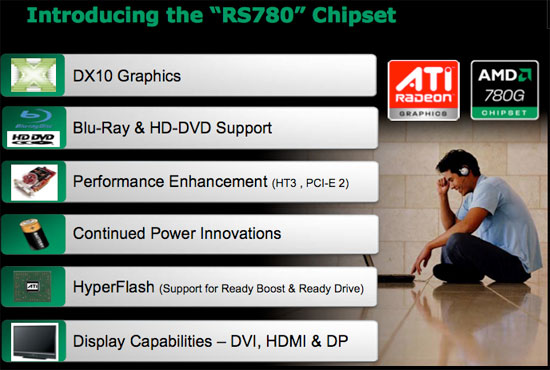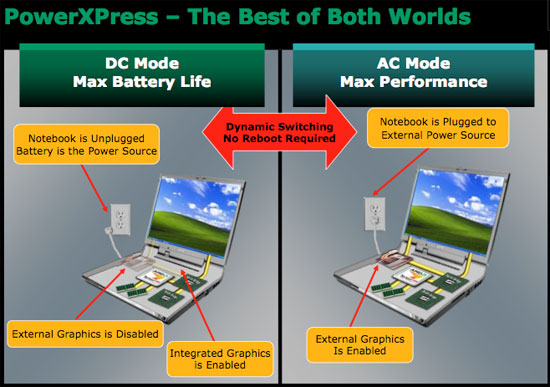AMD's Next-Generation Mobile Architecture Revealed: Griffin
by Anand Lal Shimpi on May 18, 2007 12:10 AM EST- Posted in
- CPUs
Platform
Just like Intel bundles its mobile CPUs and chipsets as platforms, AMD is doing the same with Griffin. Puma is the name of Griffin's launch platform, but unlike Intel's approach the platform only consists of a Griffin CPU and an AMD chipset; wireless networking is provided by any number of third party vendors. The CPU we already know about, but the chipset is AMD's upcoming RS780.

The chipset supports Hyper Transport 3 (obviously), PCI Express 2.0 (faster link speeds/higher bandwidth) and AMD's answer to Intel's Turbo Memory, Hyper Flash.

The RS780 features an integrated graphics core based on the R600 architecture, however AMD would not provide us any details at this point in time other the following two points. The integrated GPU will feature H.264 decode acceleration, which we're assuming is the same full pipeline UVD from the desktop R600.

Even more interesting is the platform's support for a feature called PowerXPress. The idea is that all Puma notebooks will have integrated graphics, but they can also have optional discrete graphics for better gaming performance. AMD is confident that its integrated graphics will be lower power than any discrete graphics solution, so when you're running on battery power the external graphics core would be disabled and your display would run off of the integrated GPU. On AC power, in the max performance mode, the internal graphics gets disabled and the external GPU is operational.
According to AMD, this switchover happens seamlessly; there's no reboot required and there should be hardly any interruption in use. We have yet to see it in action and are understandably skeptical of how smooth the transition between GPUs would be, but AMD claims that it works and very well at that. AMD also mentioned that this functionality could be overridden by a control panel if need be.
Griffin will use the same S1 CPU socket as current Turion CPUs, however the pinout will be different meaning that these new chips won't be backwards compatible with current Turion notebooks.
As we mentioned above, Hyper Flash will be supported by the RS780 chipset but not over the PCI Express bus. Instead, AMD is using a proprietary interface between the South Bridge and its Hyper Flash controller. According to AMD, PCI Express is not the most power efficient interface to NAND flash so it is using an alternative. AMD expects performance of Hyper Flash to be noticeably better than Intel's Turbo Memory, but without numbers to put to that claim we can't think much of it (it's rare that a manufacturer makes claims about how slow its technology is going to be).










36 Comments
View All Comments
Goty - Friday, May 18, 2007 - link
I agree with your points here, but it might have come down to an issue of time and manpower. Intel probably has teams of engineers sitting around twiddling their thumbs just waiting for something to do while AMD probably has everyone working around the clock. It's probably more a result of resources than anything.TA152H - Friday, May 18, 2007 - link
Goty,I think you're right, but a product like that could make a big difference too. It would be so different than anything out there, and have such advantages for the market it is designed for, I think it is something they should have looked at.
I guess what's so disappointing for me is they mentioned that they were going to try a completely new design for it, and then they just did another iteration of the K8 and took a branch from there. I don't think they can seriously differentiate themselves from the Core 2 line, and I think they have to. Intel is so much better in manufacturing, if AMD retains design parity, or something close, I don't know how they are going to be successful. I think Fusion is a good idea, but I don't think it's enough and I don't think it would be hard for Intel to duplicate, because as you say, they have the resources.
Besides, they have the K6, they'd have to increase the memory interface, improve the decoders, and tweak little things here and there, but it's a great processor. Remember how disappointed everyone was when the K7 couldn't beat it clock normalized for integer and it was beating the Katmais that were 50 MHz faster? This with the putrid VIA MVP3 chipset that had horrible memory performance. It was a really good design.
I am also wondering why they still have such strong x87 in the Athlons. Why even bother these days, particularly with the mobile part. Put in a tiny non-pipelined version for compatibility, and save the space for something more useful. x87 isn't even supported in x86-64 mode, so it's clearly a dead technology.
LoneWolf15 - Friday, May 18, 2007 - link
Maybe it did for Joe Sixpack, but it ticks me off. Centrino tells me nothing about what kind of processor is in a system, it just tells me that the system has a wireless card (of some sort, Intel branded but who-knows-which-model). Centrino could mean Pentium-M (Banias or Dothan), Celeron-M, or Core Solo. Centrino Duo at least tells me a system is dual-core, but not whether it's Core Duo or Core 2 Duo (or possibly "Pentium Dual Core", that relabeled Core Duo Intel is putting out in limited quantities). You call this simple? I sure don't.
I can't stand this marketing trend. There is very little way to "at-a--glance", know exactly what you are getting in a given laptop. It's just one more buzzword to know, when just saying the laptop has WiFi (which 95% do at this point) and an Intel xxx processor running at such-an-such a speed would be useful. And it looks like it gets review sites like Anandtech sucked into buzzword bingo in the process.
IntelUser2000 - Friday, May 18, 2007 - link
Actually, Celeron M based laptops can't be certified as Centrino. Here is the chart from Intel: http://www.intel.com/products/centrino/compare.htm">http://www.intel.com/products/centrino/compare.htm
And you can further differentiate the single core Centrinos from the dual cores. Dual core versions are Centrino Duo, and single core ones are Centrino. It looks like even the logo can be different for Core Solo compared to Pentium M.
acejj26 - Friday, May 18, 2007 - link
power consumption is linear with respect to frequency and quadratic with respect to voltage, not exponentialelpresidente2075 - Friday, May 18, 2007 - link
You do know that they are one in the same in this instance, right?Goty - Friday, May 18, 2007 - link
x^2 is quadratic, a^x is exponential (a being some constant).Big difference.
JarredWalton - Friday, May 18, 2007 - link
a^x is indeed exponential... and yet, x could be something like... 2! :)Seer - Friday, May 18, 2007 - link
The OP is right and you're completely wrong. I came on here to post the very same message.The definition of x in this case is that it is a variable. If both x and a were constants....you'd just have a single number. There would be no relationship. Go back to Algebra I if you truly don't understand this.
goku - Friday, May 18, 2007 - link
Seeing innovations like this where they're doing more with less just really makes me happy. It's nice to see that they're addressing power concerns and working towards having a powerful computer that also can be power conservative.While the hardware industry is getting more efficent, unfortunately the software industry is following the trend of the P4. Software is getting more and more inefficient and bloated while hardware is getting more efficient. It'd be nice if this trend would reverse and would start seeing better software written again..